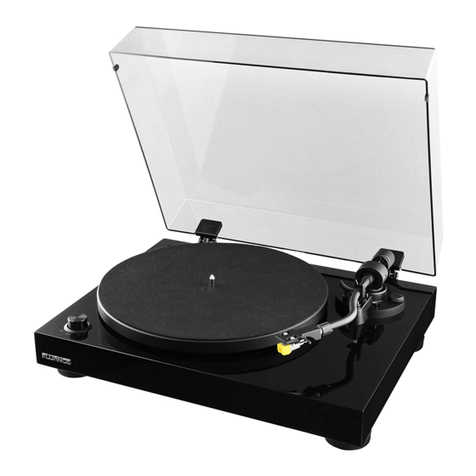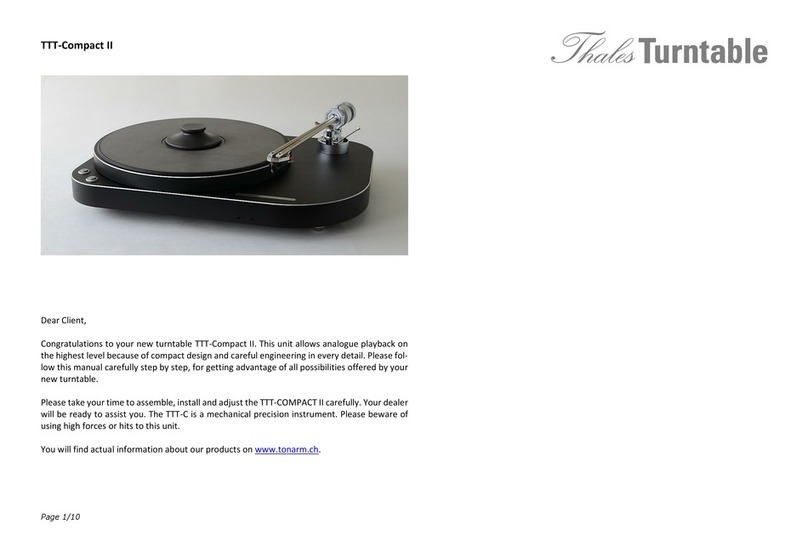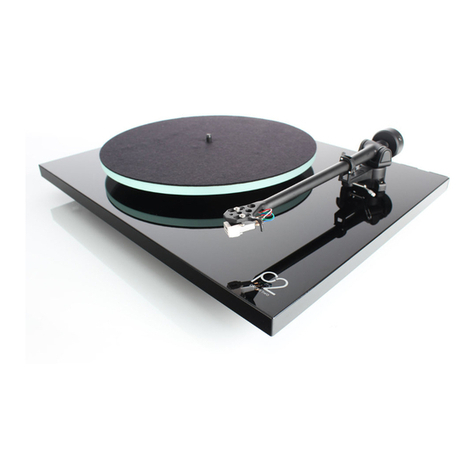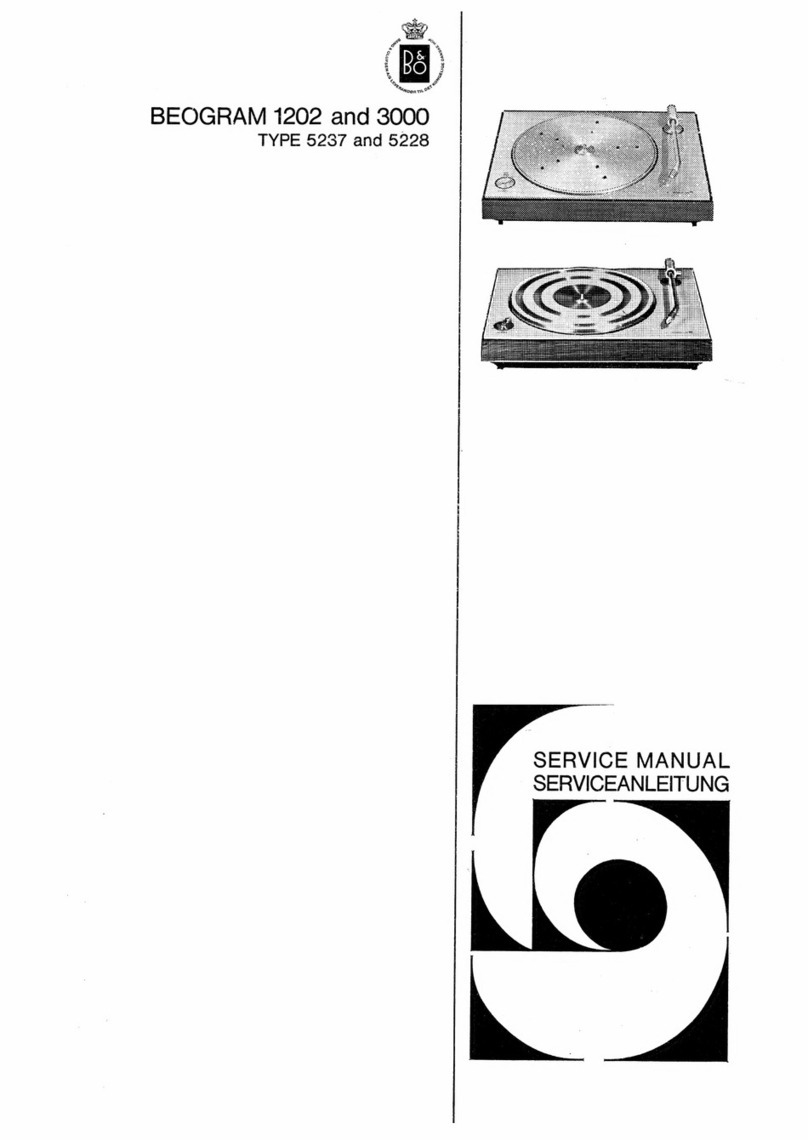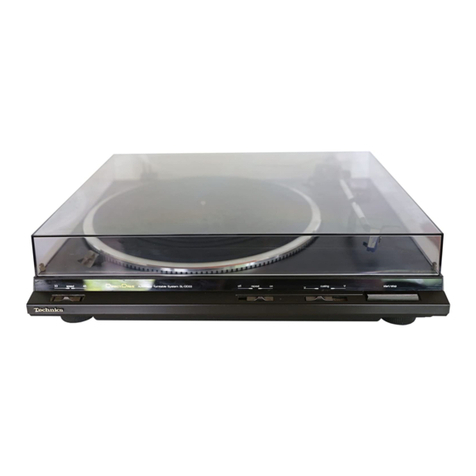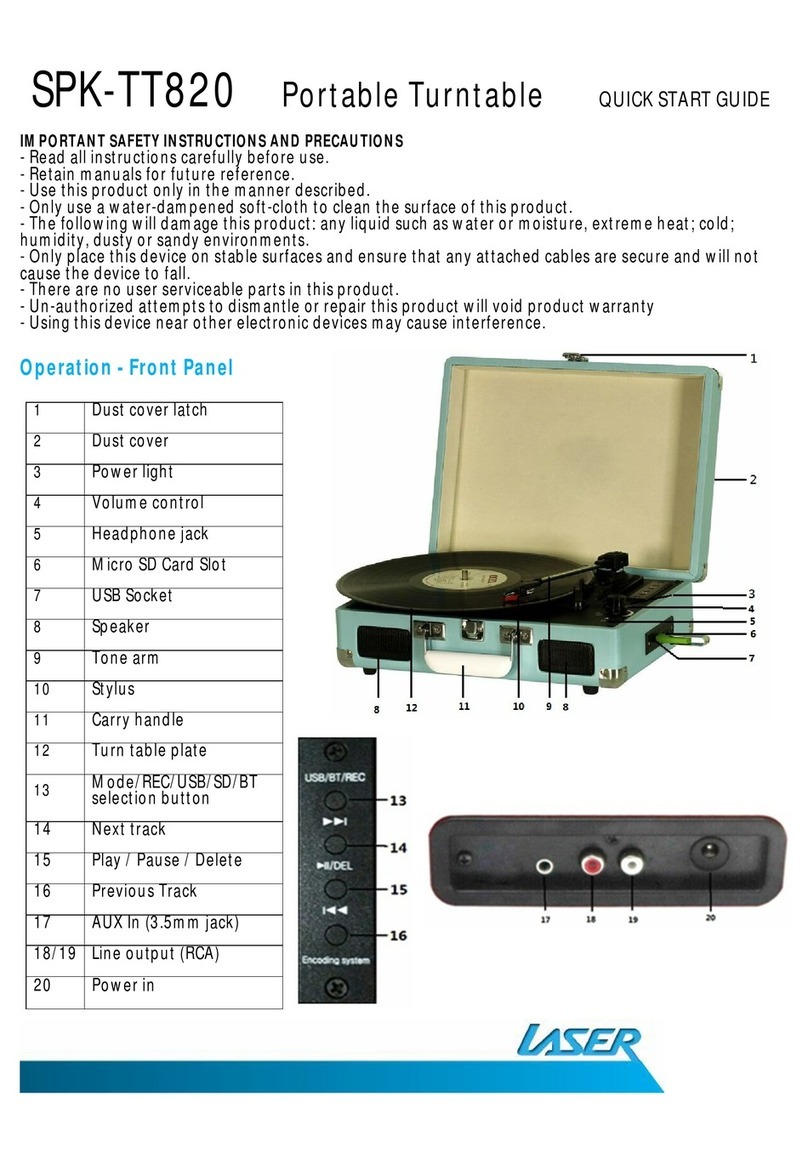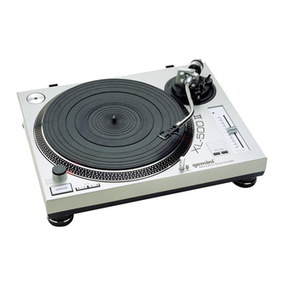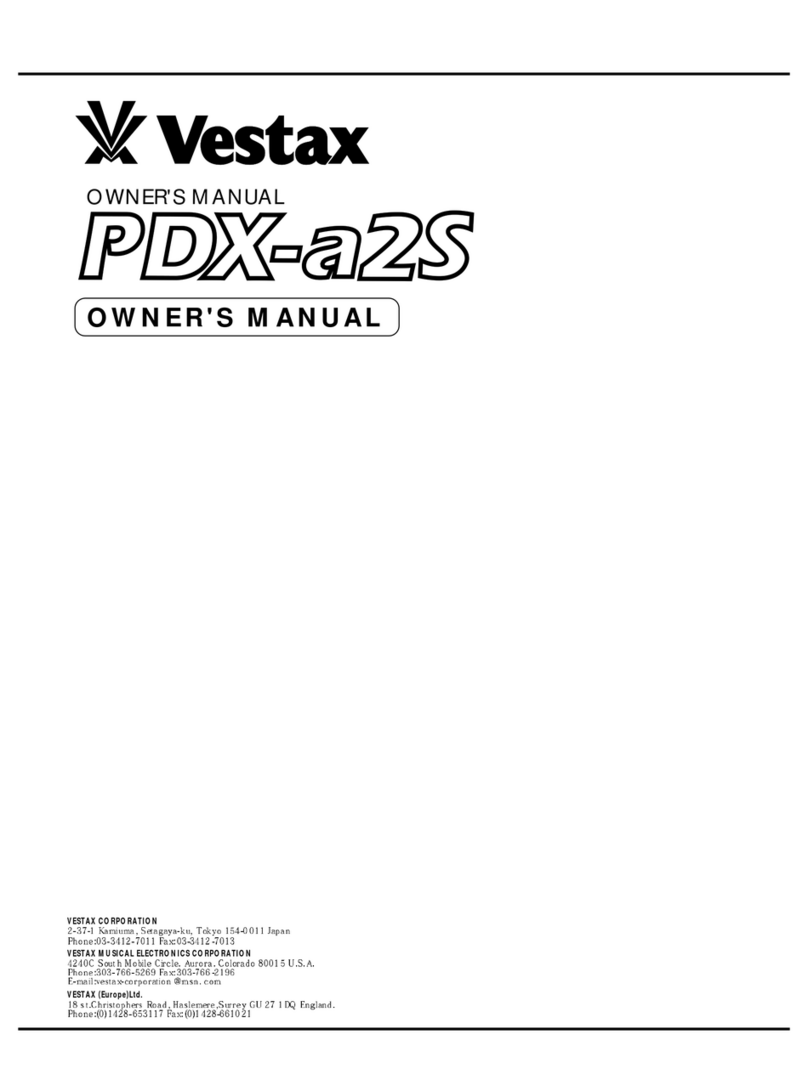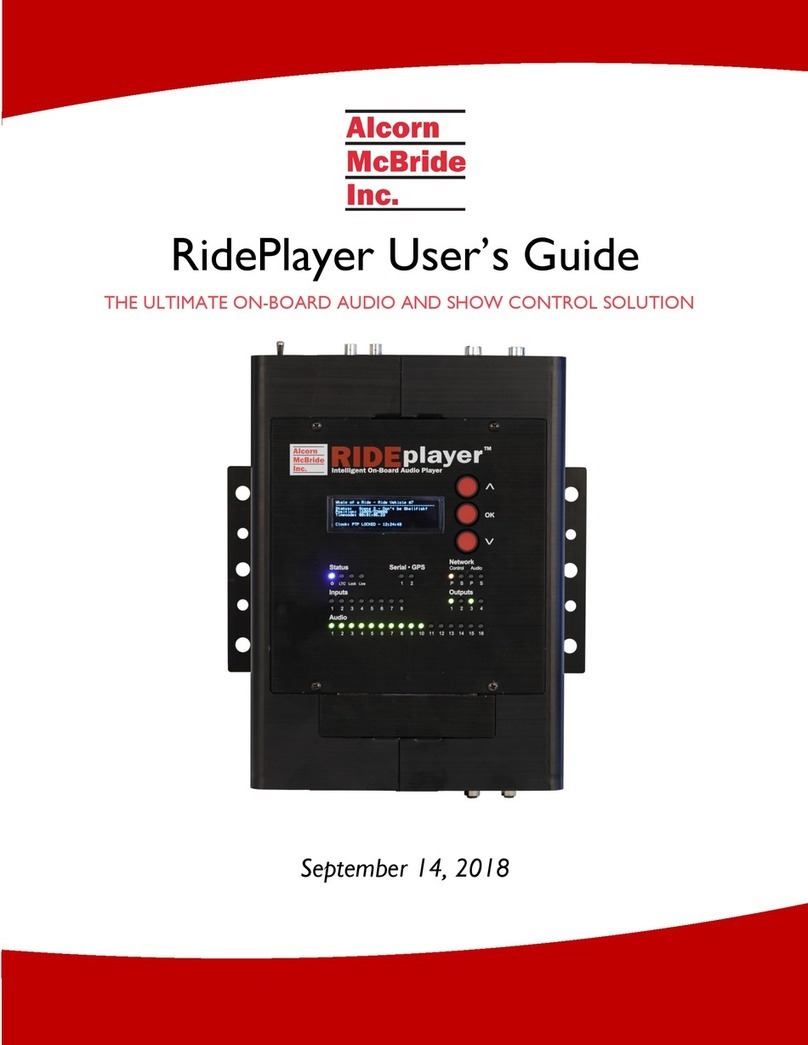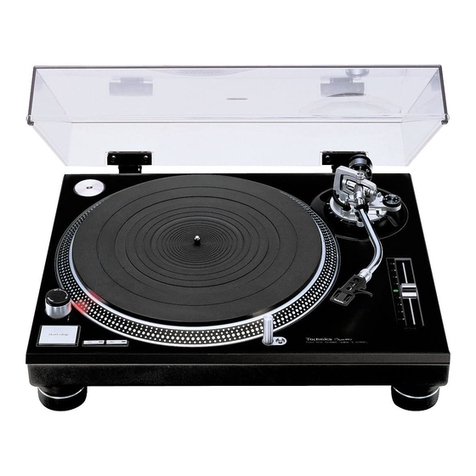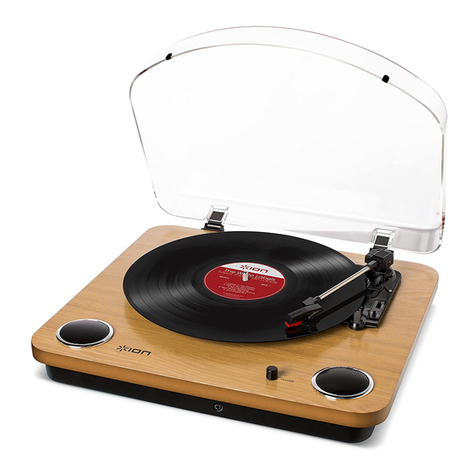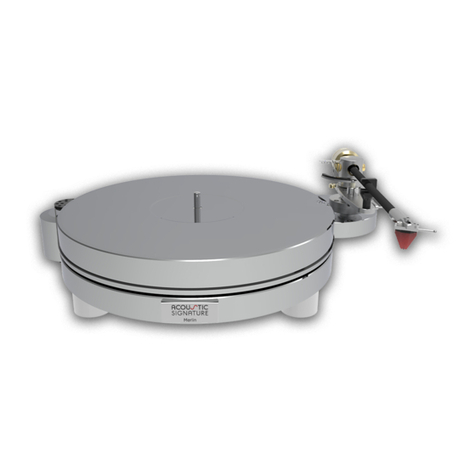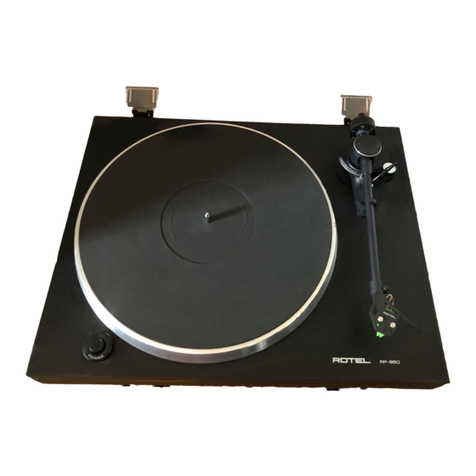H. H. MORCH DP-8 User manual

Page 1
H. H. MØRCH
DP-8
Instructions
Contents of the packing
In the packing of the tonearm you will find the arm base in which the bearings are encapsulated in a
heavy body. The bearings are the link between the moveable part of the tonearm and its support. This
support can move up and down in a bush, which is holding the arm base. A black pear shaped plate is
attached to the said bush with just one screw. This pear shaped plate is supporting the integrated
VTA device, the antiskating device and the lifter cylinder. The said bush is holding the arm base with a
big nut to the turntable chassis. A high quality cord is supplied for connecting the arm base to the
amplifier. In North America this cord is not included.
Further you will find one arm tube according to the choice that you have had from advice from your
dealer. Or you have seen the Cartridge Armtube Combination List (under Instructions) in our website.
There also will be 4 weights with O-rings, 4 weights with screws, finger lever with screws, knurled nut,
hexagon spanner, syringe with silicone fluid, a thin plexiglass rod and a narrow piece of thick paper.
The tonearm usually is supplied with the arm rest mounted on the pick-up lifter, but if desired a
separate arm rest could be supplied instead.
Spatial requirements
The vertical distance between the plane where the tonearm is mounted to the plane where the record
is placed should be between 28 mm (1 1/8”) and 40 mm (1 9/16”).
If the diameter of the turntable platter is larger than 32 cm (12 5/8”) then it is recommended to use a
12” armtube.
Mounting the bush
First it has to be decided exactly where to place the bush with the arm base. The center of the bush
should be at a distance of 212 mm (8 5/16'') from the center of the turntable platter and there has to
be room enough for the counterweight rod to move freely.
Fig. 1. The outline of the white area is indicating the room needed for the tonearm.

Page 2
The counterweight rod is having a rear overhang of 70 mm (2 3/4”) as to the center of the said bush. If
there is plenty of room for the counterweight rod consideration should be taken as to where the arm
base should be positioned to give a convenient position for the armtube when resting in the arm rest.
(See fig. 1)
If a separate arm rest is used, it should be placed so that the armtube when resting on it is at a suit-
able distance from the record.
Mark the center of the hole for the bush and check that the distance to the center of the turntable
platter is 212 mm (8 5/16"). Then drill a 20 mm (13/16") hole with center in this mark. Also, if separate
arm rest is used, drill a 10 mm (13/32") hole for the bush for the arm rest about 155 mm (6 1/8") in
front the 20 mm hole.
Accommodate the bush with the heavy central body of the tonearm in the 20 mm hole so that the
“narrow” end of the black pear shaped plate is pointing forwards. Then pull out the piece of rubber,
which is squeezed in under this heavy body.
Put the armtube on top of the arm base with the 5 pins in the flange of the armtube inserted into the 5
holes in the plexiglass. Secure the armtube with the knurled nut screwed onto the thread going
through the flange of the armtube.
The position of the black pear shaped plate must be adjusted so that the armtube can move in a
suitable angle over the turntable platter and so that the armtube can rest in the arm rest in a suitable
distance from the turntable platter: Move the armtube resting on the girder of the raised pick-up lifter
all the way to the end of the girder. Then turn the pear shaped plate, so that the position of the stylus
is on line with the direction from the center of knurled nut holding the armtube to the center of the
turntable spindle.
Then put the big nut onto the thread of the bush and tighten it - making sure that the bush with the
pear shaped plate does not turn (Fig. 1).
Mounting the cable to the amplifier
Put the plug of the tonearm cord into the socket inside the bottom of the arm pillar. Make sure that the
big nut holding the arm base is tightened before pushing the connector of the tonearm cord into the
arm base. Try to avoid bending the cable too sharply right next to the tonearm connector. If the
turntable has a floating sub chassis, the cable should not be restricted in any way, and it should be
arranged in a suitable arc, so that it does not limit the free movements of the suspension. Remember
that the ground wire should always be connected to the chassis (ground terminal) of the amplifier. The
chassis of the turntable in most cases also has to be electrically connected to the arm base.
Putting on the side weights
First the weights for the side rods should be put on. Take the smaller of the weights with screws and
hang one on each side rod (without tightening the screws). Then likewise take the bigger weights with
screws and hang one on each side rod (Fig. 2).
Fig. 2. All the weights with screws hanging on the side rods.

Page 3
Push the armtube towards the turntable spindle so that one of the side rods touches the VTA spindle.
Push the weights in this side towards the VTA device while holding the enclosed thick paper between
the VTA device and the smaller weight. With the smaller weight in this position put the hexagon key
into the screw of this weight. Still with this weight pushing on the paper turn the weight so that the
hexagon key is pointing backwards and a little down from horizontal (Fig. 3) and then tighten the
screw of this weight slightly. The width of the thick paper is the same as the distance from the smaller
weight to the heavy body, where the side rod is attached.
Fig. 3. Tighten the screw of the smaller weight with the paper as a spacer.
Move the weights on the other side rod so that they hang symmetrically as to the center line of said
heavy body.. Then with the paper check that the smaller of the weights hanging here has the same
distance from the body as the same weight on the other side (Fig. 4).
Fig. 4. The paper fits the spacing of the smaller weight adjusted at the
VTA device and is used as spacing for the smaller weight on the other
side.
With this distance and with the hexagon key pointing backwards and a little down (Fig. 5) tighten the
screw slightly.

Page 4
Fig. 5. Tightening the screw of the smaller weight on the other side.
On each side put the paper between the bigger weight and the smaller weight and push the bigger
weight slightly towards the smaller weight. Then tighten the screws a little having the hexagon key
pointing backwards and about 30O up from horizontal (Fig. 6).
Fig. 6. All the side weights mounted shown with the
paper as spacer between two of them and the hexagon
key in one of them.
Coarse adjustment of lateral balance
Raise the pick-up lifter. Using the supplied plexiglass rod, move the counterweight rod up by 1 mm
and check that the weights on each side move up at the same time (Fig. 7). If not, loosen the screw
for the larger weight that moves up first, move it slightly outwards and re-tighten the screw. Check
again and re-adjust as necessary. For fine adjustment see Lateral Balance (Fig. 13).

Page 5
Fig. 7. By raising the counterweight rod 1 mm the weights in both sides must come up simultaneously.
Putting on the counterweights
Then the weights with O-rings for the counterweight rod should be put on. In order to make it possible
to balance all phono cartridges the tonearm is supplied with three counterweights - large, medium,
and small - having the hole eccentrically positioned and with a tracking force weight having a centrally
positioned hole.
The weights that are to be chosen for balancing a cartridge depend on which arm tube that is to be
used and on the weight of the cartridge. With the lighter armtubes the small counterweight and the
tracking force weight is put onto the counterweight rod. With the heaviest armtube “blue” the large
counterweight and the tracking force weight is put on (in the said sequence).
You may have to put on more than one counterweight. Start putting onto the counterweight rod the
largest counterweight. Then the smaller one etc. and at last the tracking force weight. To put on the
counterweight/s and to displace them along the counterweight rod they have to
simultaneously be revolved to and fro.
Use as many counterweights as possible, but still there has to be room for the tracking force weight to
move.
Refilling the silicone fluid
Fig. 8. Injecting silicone into the lifter cylinder.

Page 6
Take off the armtube. The accompanying syringe contains about 0.6 ml of silicone fluid. Pull the black
piston out of the lifter cylinder and place it in a completely clean place. Then inject 0.05 ml but
absolutely no more than 0.1 ml of the fluid behind the lifter handle shaft inside the lifter cylinder.
When doing this the lifter handle must be in "lowered" position (Fig. 8).
When the fluid is injected, the tip of the syringe is "wiped off" on the shaft, and the syringe is pulled up
with a little jerk thereby preventing the fluid from getting in touch with the walls of the lifter cylinder. Do
not put the piston back into the lifter cylinder until the silicone fluid has merged down to the bottom of
the cylinder, and hereafter the piston must not be pulled up again, as the silicone fluid would then
easily stick to the walls of the lifter cylinder. If this happens the piston will descend much too slowly.
The silicone fluid can also be used for damping the vertical mode of motion, something that is rarely
an advantage. If desired anyway, please request from your supplier a separate document describing
the procedure.
Mounting the cartridge
Fig. 10. A cartridge mounted by using the finger lever and screws.
Using the accompanying finger lever the cartridge can now be mounted on the armtube (Fig. 10). If
possible, use the accompanying aluminum screws. Provided that the tonearm is mounted, so that the
distance from the pivot to the center of the turntable is as indicated in Fig. 1, the position of the stylus
- to obtain correct overhang - should be: with standard armtubes right under the front edge of the
black plane of the armtube - with PRECISION armtubes 4 mm (5/32”) behind the front edge. Also the
cartridge should be in parallel to the said black plane. Carefully push the terminal jacks of the wires
unto the pins of the cartridge with a pair of tweezers. Do not force them too much and also see that
you are not squeezing the thin wiring too hard. Red and green are signal and ground of the right
channel. White and blue are signal and ground of the left channel.
The flange of the armtube having 5 contact pins now is pushed down on the threaded rod on top of
the arm base. It is fastened with the accompanying knurled not, which should be tightened well with
two fingers. Check that the overhang is correct - 18 mm (23/32”) for 9” armtubes - and adjust if
necessary. The easiest way to check that the overhang is correct is to put a ruler on the turntable
platter, so that one of its sides touches the turntable spindle. Then turn the turntable platter, so that
the said side of the ruler points to the center of the knurled nut on top of the armtube. Then the
armtube is moved so that the stylus is brought on line (above the said side of the ruler) with the
direction from the center of the turntable spindle to the center of the said knurled nut. The distance
from the center of the turntable spindle to the stylus (overhang) can be accurately observed by looking
at the scale of the ruler between the stylus and the turntable spindle. Look at right angles to the ruler.
Of course an alignment protractor will help to align more accurately.
Adjusting the tonearm
Using the VTA, adjust the height of the arm base so that the antiskating spring is at level with the
record.

Page 7
Put the tracking force weight near the end of the counterweight rod. Move the counterweight/s
backwards or forwards until the arm tube is balancing in about horizontal position. When doing this,
see that there is space to move a weight forwards to apply tracking force. The large counterweight
gives 2 g when moved 1 indentation forwards. The medium counterweight gives 1.2 g when moved 1
indentation forwards and the small counterweight gives ½ g when moved 1 indentation forwards.
Rotate the counterweight/s so that the center of gravity is pointing upwards. It also could point
downwards. The two settings influence the room of the stereo image.
Apply tracking force by moving a counterweight and/or the tracking force weight forwards. If not all the
tracking force is applied by moving a counterweight forwards, then also slide the tracking force weight
forwards. Moving the tracking force weight forwards 1 indentation will give ½ g tracking force. When
adjusting the weights they should be arranged, so that there is space on the counterweight rod to
move the tracking force weight forwards and backwards. This will make it easy to audition the best
setting of the tracking force.
If it appears that one counterweight can not get far enough forwards to obtain the correct tracking
force, then also –if more than one counterweight is used - move another counterweight and/or the
tracking force weight. If there is not enough space to move the weights forwards to give the correct
tracking force a counterweight should be replaced by a smaller one.
The height of the tonearm now should be fine adjusted. With the stylus resting on a record the arm
base is moved downwards or upwards with the VTA device, until the arm tube is in parallel to the
record, and it is checked, that the arm base is rotated horizontally, so that the pick-up lifter can
support the arm tube all the way to the center of the record. If necessary loosen the big nut and
adjust.
The height of the pick-up lifter is adjusted so that the stylus is about 4 mm (5/32”) above the record,
when the pick-up lifter is in "raised" position. Use the screw in the front of the black plate holding the
pick-up lifter. (Fig. 11.)
Fig. 11. Adjusting the height of the pickup lifter.
Hold the lifter handle with two fingers of your right hand, so that it is pointing straight up. Support
these fingers on the black plate holding the lifter cylinder. Put the hexagon key into the screw in front
of the lifter cylinder, and with your left hand loosen the screw. Then carefully raise or lower the pick-up
lifter a little bit - only so much that in this position, the stylus is raised about 4 mm above the surface of
the record. At the same time see that the girder is not moved horizontally, so that the arch, it is
performing as seen from above, still has its center in the knurled nut on top o the arm base. Tighten
the screw again.

Page 8
If a separate arm rest is used, it is adjusted to a height, so that the arm tube rests on it, when the pick-
up lifter is in "raised" position.
Center of Gravity
Raise the pick-up lifter. Put the black rubber between the lifter cylinder and the spring for antiskating,
so that the spring doesn't pull. Be very careful not to bend the spring. Slide back weights, so that the
stylus is "floating" at level with the record surface. Lower the pick-up lifter. Raise the cartridge as
much as you can with your finger and take away the finger. The cartridge should move very slowly
down, so that the stylus ends up "floating" at level with the record surface.
If the center of gravity is too high the cartridge will stay up. Then it also would have been a little tricky
to find the "0"-point. The center of gravity can be lowered by turning the "heavy" end of a
counterweight down - if it was pointing upwards. Also the "heavy" end of the big sideweights could be
turned just a little down.
If the stylus is quickly moving down to the 0-point, the center of gravity is too low. Then the heavy end
of the medium side weights should be turned a little up. Also the heavy end of the big side weights
could be turned a little more up.
After adjusting any of the weights - except the tracking force weight - the lateral balance should be
adjusted again (Fig. 13). After that also the tracking force.
Cartridge azimuth
Azimuth (inclination of stylus as seen from the front) may have to be adjusted. When the stylus is
resting on a record, the stylus - and so the cartridge - should stand at a right angle as to the record.
If it does not, put the long end of the hexagon key from the plastic container into the hole in the right
side of the flange of the armtube. That is as seen from the front into the hole in the heavy end of the
armtube sitting on top of the arm base.
If you imagine the armtube taken off, the hexagon key would sit in the arm base as shown in Fig. 12.
But only in your imagination. In reality the armtube is sitting there.
By turning the hexagon key clockwise the arm - and so the cartridge - will be tilted to the left. By
turning it counter clockwise the cartridge will be tilted to the right. Look at the front of the cartridge
and the mirror image of it in the record. They have to be on line.
Fig. 12. Armtube is imagined taken off, and in this image the hexagon key, in reality going through the
flange of the armtube, is ready to turn the pivot up or down.

Page 9
Lateral balance
The direction of the counterweight rod extended to the stylus is the line of lateral balance. The lateral
balance was coarse adjusted after mounting the weights on the side rods (see Fig. 7).
Fig. 13. Fine adjustment by turning the heavy end of any counterweight to the side that comes up first.
Fine adjustment can be done in the same way but with the armtube resting on the raised pick-up lifter,
and the anti skating handle should be turned as far counter clockwise as possible. Usually for fine
adjustment it will be enough to turn the “heavy end” of any counterweight on the counterweight rod in
the direction of where the side weights are coming up first (Fig. 13). Then try again to raise the
counterweight rod with the plexiglass rod, a.s.o. until both sides come up simultaneously. When
adjusting, make sure that the stylus doesn’t touch anything.
Antiskating (see fig. 14)
The antiskating force is adjusted with the little black handle A next to the pick-up lifter. The amount of
antiskating force required depends on the tracking force and the shape of the stylus. Thus no
calibration is possible.
Fig. 14. Adjustment of antiskating

Page 10
Coarse adjustment can be done with the stylus running between the grooves next to the label of the
record:
Without starting the turntable motor, place the stylus between these grooves. Then move the turntable
platter slowly forwards with your hand. The stylus should move inwards slowly. Then move the
turntable slowly a little backwards. The Stylus should move outwards.
Correct antiskating is when you move the turntable forwards and the stylus moves inwards with such
a slow speed, that it will stay between the grooves until it gets to the center groove.
Fine adjustment could be done by reducing the tracking force a little whilst listening to a critical
passage. If for instance distortion occurs in the right speaker, the handle should be turned clockwise.
(The best result is obtained with a test record). The adjustment is not critical. It is better giving too litte
than too much antiskating force.
The range that the antiskating handle A can move, will cover most cartridges.
If the handle A is turned in the direction of the arrow the antiskating will increase - and decrease if it is
turned the opposite way. If the handle cannot be turned enough to get more antiskating or to get less
antiskating the disc under the screw B should be adjusted. Hold it with two fingers of the left hand,
while the screw B is loosened with a not too small screwdriver, and the disc is turned ½ revolution or
more either in the direction of the arrow if more antiskating force is desired or in the opposite direction.
Then the screw should be tightened again. The antiskating then can be adjusted with the handle A in
a range with more or less antiskating than before.
Please note that the stability of the horizontal mode of motion is obtained as a co function between
the heavy sideweights and the excessive damping in the horizontal plane. If the armtube is
moved horizontally in and out with a hand, there will be resistance to feel
against the movement. Only if the armtube is moved very slowly there will be
no resistance.
Special about PRECISION arm tubes
PRECISION arm tubes are supplied in "red" and "blue" versions only. They have a wide and very
precisely ground mounting plane to assure a good mechanical contact to cartridges that have a
similar large and accurate mounting plane. The PRECISION armtubes are 4 mm (5/32”) longer than
the NARROW ones in the forward direction.
Special about 12” armtubes
12” arm tubes are supplied in "red" and "blue" versions only. They are supplied only with the narrow
headshell.
In the section Mounting the bush it is described how the position of the 20 mm (13/16”) hole is found.
For 12” armtubes the distance from the center of this hole to the center of the turntable patter should
be 294.1 mm (11 9/16”).
If the bush is mounted at above distance from the center of the turntable platter, the stylus should be
positioned a little behind the front edge of the black plane of the arm tube. After mounting check that
the overhang - 13.3 mm (17/32”) - is correct and adjust if necessary.
With 12” armtubes more counterweights should be used than with 9” armtubes. With the heaviest 12”
armtube “blue” usually all the weights should be on the counterweight rod. If even the cartridge is
heavy, the weights should be put on in opposite sequence, so that the large counterweight is at the
end of the counterweight rod.
The sound image most likely will be the best, if the counterweights are adjusted with the center of
gravity above the counterweight rod.
Table of contents
